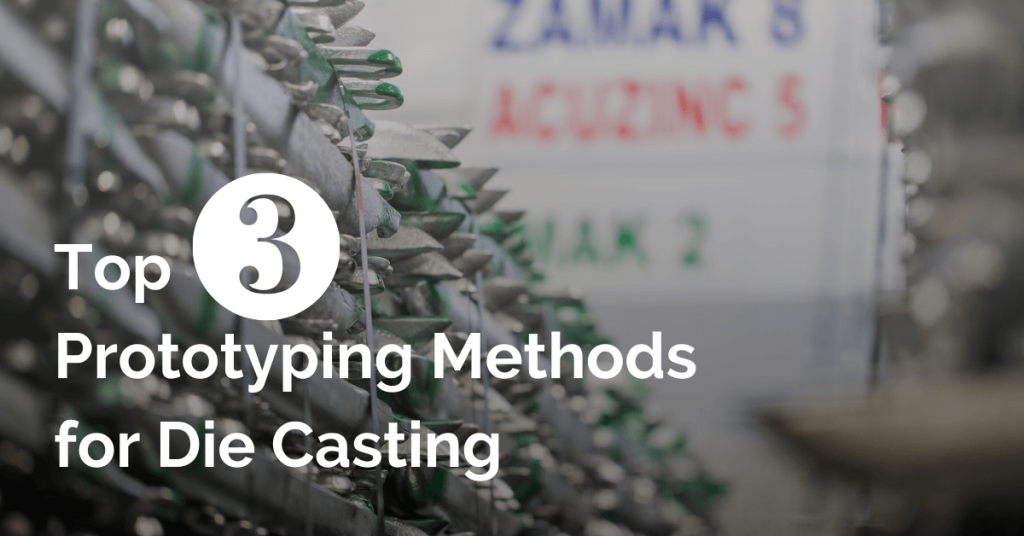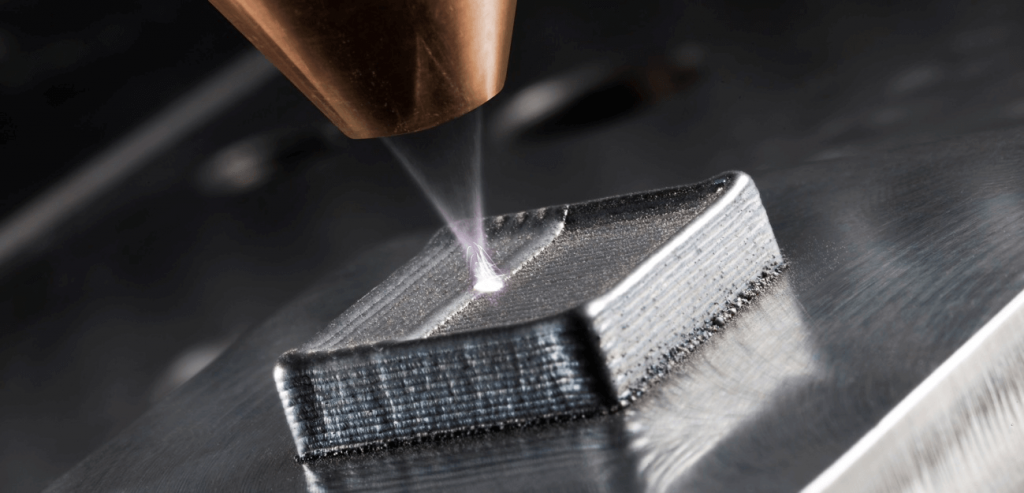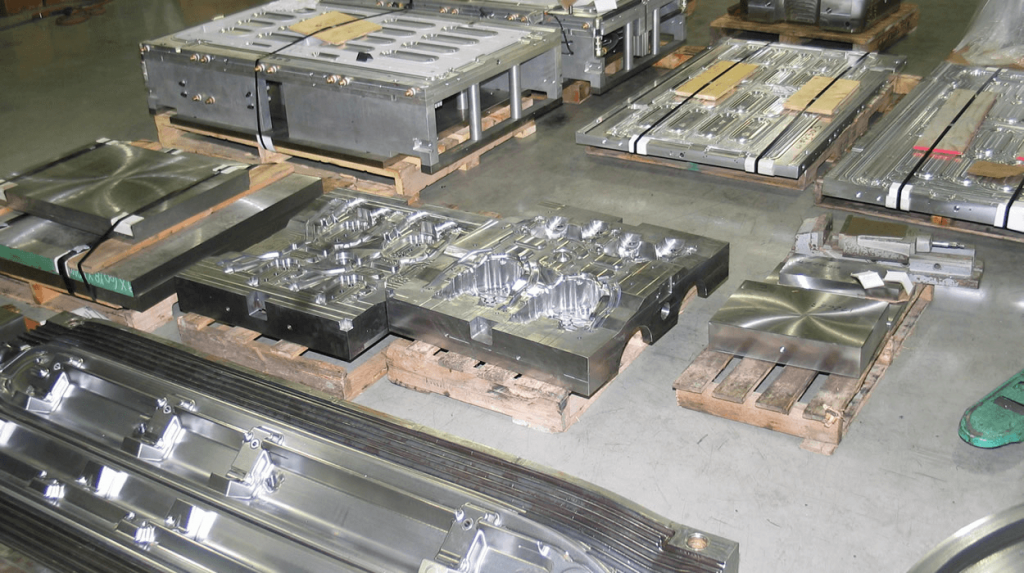Como o fabricante de fundição de alumínio e prototipagem rápida obtêm protótipos de qualidade?
Fabricante de fundição sob pressão de alumínio e prototipagem rápida

O baixo ponto de fusão do fabricante de fundição permite o uso de um molde permanente. Da mesma forma, usamos este aço para fazer peças de fundição. Na fundição sob pressão, um pistão de injeção empurra o alumínio líquido para a cavidade do molde.
Later, it compresses the part during solidification. Typically, liquid metal reaches attack speeds of up to 60 meters per second. Similarly, the applied pressure can reach up to 800 bar during solidification.
The molding press keeps the mold closed by a closing force. It is for to contain the pressure exerted on the part, it depends on the size of the cavity and the pressure applied by the piston.
What is the capacity of aluminum die casting machines?
The smallest presses have a capacity of 1000 kN and the larger ones 35000 kN. The force of the press is therefore directly related to the projected surface of the molded part.
Generally, the die-casting process is divided into 6 phases:
- transferência de metal líquido
- fase de abordagem de injeção
- injeção rápida
- Intensification
- ejection and mold lubrication
Each phase is optimized to maximize the production rate. Moreover, it minimizes the number of rejected parts.
Existem três variantes do fabricante de fundição :
- Traditional die-casting
- Fundição a vácuo, incluindo fundição a vácuo para aplicações estruturais
- Fundição sob pressão semi-sólida, muito menos comum.
The main advantage of the process is the rapid rate. It makes it possible for aluminum die casting manufacturer & rapid prototyping to lower production costs. Moreover, it helps to approach mass markets such as the automobile.
Why rapid prototyping?
O rápido resfriamento fornecido pelo molde de metal produz uma estrutura metalúrgica muito fina na superfície chamada pele. Contribui para a obtenção de boas propriedades mecânicas.
The surface finish and dimensional tolerances are excellent. On the other hand, the design freedom is practically limited to the opening axis of the mold.
What is the process of aluminum die casting & rapid prototyping ?
The process requires little labor. But it consumes a cost of immobilization and tools. For a large run of over 10,000 parts, the fabricante de fundição offers the lowest production cost per part among foundry processes.
The main disadvantage of the traditional process is the presence of porosity in the center of the die-cast parts. It is due to the air trapped during injection. The presence of trapped air causes blistering when the room is heated.
These blisters are caused by the expansion of the gas trapped in the room. In addition, they do not allow standard heat treatments. It is for to obtain optimal mechanical properties. This phenomenon also limits the use of soldering.
Fortunately, the mechanical resistance is ensured by the skin of the molding. It means that fabricante de fundição molds several castings by this method.
What is the role of alloys in aluminum casting?
It represents more than 50% of the aluminum castings produced. In traditional pressure casting, secondary alloys are often used with a high proportion of alloying element. It gives good mechanical resistance despite an elongation of less than 3%.
T5 type heat treatment is used to increase the mechanical strength of die-cast alloys. It happens without causing blistering of the parts. Secondary alloys are often used with a high proportion of alloying element.
It gives good mechanical resistance despite an elongation of less than 3%.
How does Aluminum die casting manufacturer & rapid prototyping get quality prototypes?
Fabricante de fundição de alumínio e prototipagem rápida obtains very good part quality by using a vacuum in the cavity. It prevents air trapping. Moreover, it controls the molding cycle in real time.
The high vacuum pressure process allows to obtain a maximum elongation at break. Moreover, it makes the heat treatment possible for the parts. These developments are motivated by the weight reduction of land vehicles.
Generally, vacuum die casting provides the ideal solution of a high speed casting process. Therefore, it is best for structural parts cast in aluminum. The development of this process is currently the most active in the field of fabricante de fundição.
Elements of a mold and production cell
The die-casting process is divided into two principles.
- Hot chamber technology and
- Cold chamber technology.
The hot chamber process uses a piston. It places directly in the molten metal bath to feed the mold. Similarly, the cold chamber process uses a “cold” container. We transfer the liquid metal in it by ladle.
Description of die casting mold
In most cases, the pressure mold is made up of two ferrous alloy metal shells. Depending on the number of pieces provided, the materials used for the manufacture of the shells are:
- H13 type tool steel
- Type 4140 alloy steel
- P20 tool steel for the support parts
Fabricante de fundição de alumínio e prototipagem rápida makes the ejection rods with a harder material. Moreover, in some cases they get surface treatment. It limits sticking of the aluminum.
What is aluminum die casting mold?
The mold is composed of a fixed part on the side of the liquid metal supply. Similarly, it has a movable part on the other. The fixed part contains the metal entry hole and part of the coin cavity.
It can also have cores to mold cavities in the part. The mobile part contains the ejection rods used for remolding. It is for the cores and the part impression. The molds are equipped with oil or water cooling channels. It also serves to preheat the mold initially in the case of hot oil.
How does aluminum die casting manufacturer & rapid prototyping reduce prototyping cost?
To reduce tooling costs, the cavity often consists of a main insert placed in a larger, permanent frame that can produce more than one type of part. The inserts or molds typically belong to the customer.
The process is well suited for thin walls down to 1.5mm. It is preferable to use uniform sections which solidify simultaneously. There are no weights. Moreover, the attacks on the parts are small to facilitate cutting on debarring presses after casting.
The design of the parts makes extensive use of the ribs. It is to increase rigidity and mechanical strength. Subsequently, it also helps fill the cavity quickly before the alloy solidifies.
The turbulence of the metal in the cavity is controlled by the following factors:
- speed of metal injection
- the size and positioning
- the shape of the cavity and
- Use of wash heels
Aluminum die casting manufacturer & rapid prototyping use it to balance the movement of the metal. Moreover, they use it to capture the inclusions formed during filling. In the case of vacuum, the vacuum application parameters are also important for filling.

The injection unit is a complex hydraulic system. It consists of following parts:
- an injection accumulator
- an injection cylinder
- multiplier accumulator
- a multiplier cylinder and
- a cylinder positioning cylinder
How to control aluminum die casting speed?
These components make it possible to modulate the speed of the injection piston in 3 phases. Thanks to the fabricante de fundição during filling. It also includes metal compaction using the multiplier accumulator.
Modern systems allow precise control of the speed curve. Moreover, it also carries a gradual transition between approach and filling speed.
The closure unit is composed of a movable plate. It contains the ejection system. In addition, it carries a fixed plate. Here the coupling with the injection unit locates.
A closing system consisting of toggle levers is used to apply the closing force to the machine plates. This closing force must be greater than the force exerted by the metal.
A força exercida pelo metal é calculada de acordo com a seguinte fórmula:
F = P int * A
- F é a força exercida pelo metal
- P int é a intensificação da pressão e
- A é a área projetada da peça
Normalmente, é recomendável ter uma força de fechamento. Deve ser pelo menos 20% maior que a força de abertura exercida pelo metal. Fabricante de fundição de alumínio e prototipagem rápida tornam a prensa com uma estrutura sólida.
Além disso, ele garante o alinhamento das placas móveis e fixas por quatro colunas rígidas. Essas colunas são tensionadas pelo efeito do sistema de fechamento. Eles devem ter um bom equilíbrio para promover a aplicação uniforme da força de fechamento.
A impressora está equipada com conexões periféricas. Essas conexões consistem em:
- sistemas do molde
- cilindro e pistão de injeção
- dosagem de metal líquido
- lubrificação automática do molde
- corrente de ar, controlador lógico programável
- operação de interfaces e elementos de segurança
Como fabricante de fundição de alumínio e prototipagem rápida controlam o ciclo de injeção?
A impressora também pode conter um sistema para aquisição de dados. Além disso, fabricante de fundição usam-no para controlar o ciclo de injeção em tempo real. Sensores de resposta rápida medem a pressão e a posição do pistão de injeção.
Isso ocorre quase instantaneamente com feedback para manter os parâmetros dentro das faixas predefinidas. As informações podem ser registradas para controle estatístico de qualidade.
Qual é o papel do lubrificante na moldagem?
The lubricant is used to facilitate demolding and to cool the mold. However, this practice tends to be minimized. Because of the greater availability of simulation software. We use lubricant and optimizing cycle time.
The lubricant applied to the mold between injections is 100% liquid. It does not contain any ceramic suspension. Similarly, it does not affect dimensional tolerances. It is applied manually or, more often, automatically.
The thermo regulation system consists of a mold heater. It has heat transfer fluid. Subsequently, it also serves to cool the mold. This can also be connected to a sophisticated temperature acquisition system.
The cell can contain a water pan to quench the parts. The production cell can be fully robotized from loading the holding furnace
Aluminum die casting manufacturer & rapid prototyping tooling design
O fabricante de fundição is responsible for the design of the mold. It includes the following features:
- Design of drawer cores for complex cavities
- Added draft angles
- Design of the feed system
- Design of the ejection system
The modeling of the filling and the solidification is widely used for the design of the die-cast molds. Subsequently, it is due to the high costs of modification of the tools.
A part design suitable for the foundry from the start increases the degree of success. You can do it by putting a part into production by die casting.
In general, you should:
- Use uniform thin sections
- Avoid isolated metal masses away from supply channels
- Use radii and limit sharp angles
- Use ribs instead of solid walls
- Take into account the demoulding axis and
- the associated loss of design degree of freedom
Take into account associated tolerances above and below the mold that are not molded together
Expect the cast to have draft angles and be marked by the ejection rods.
Advantages and Capabilities of Die Casting
Fabricante de fundição de alumínio e prototipagem rápida offers the best dimensional tolerances among the casting processes. Fine details and small cavities can be cast as well as fine identification lettering.

Die-casting is characterized by the possibility of molding parts. Furthermore, it has thin walls up to 1.5 mm, surrounded by reinforcing ribs. The surface finish is excellent. Moreover, 60 micro inches RMS is easily obtained. But a value of 90 micro inches RMS is more conservative.
Geralmente, é possível fazer peças estruturais. Graças à estrutura fina devido ao resfriamento rápido. Facilita o uso de vácuo e ligas primárias com baixo teor de ferro.
Também é possível instalar insertos no molde. Portanto, fabricante de fundição realizam a moldagem. O aço é seu exemplo óbvio.
O processo tem certas vantagens ecológicas. Tal como:
- A eliminação de moldes de areia
- a possibilidade de usar ligas recicladas e
- o mínimo de acabamento após a moldagem
A pressão muito alta do metal exclui o uso de núcleos de areia. Se um núcleo de metal for usado em outro eixo, este deve resistir ao impulso do metal. Portanto, seja auxiliado por um sistema hidráulico mais potente.
Fabricante de fundição de alumínio e prototipagem rápida therefore try to avoid the use of cores. Otherwise, we use a core which is ejected with the part and removed after casting.
Note the use of the salt core for complex cavities. Similarly, it is then removed by cleaning with water.



